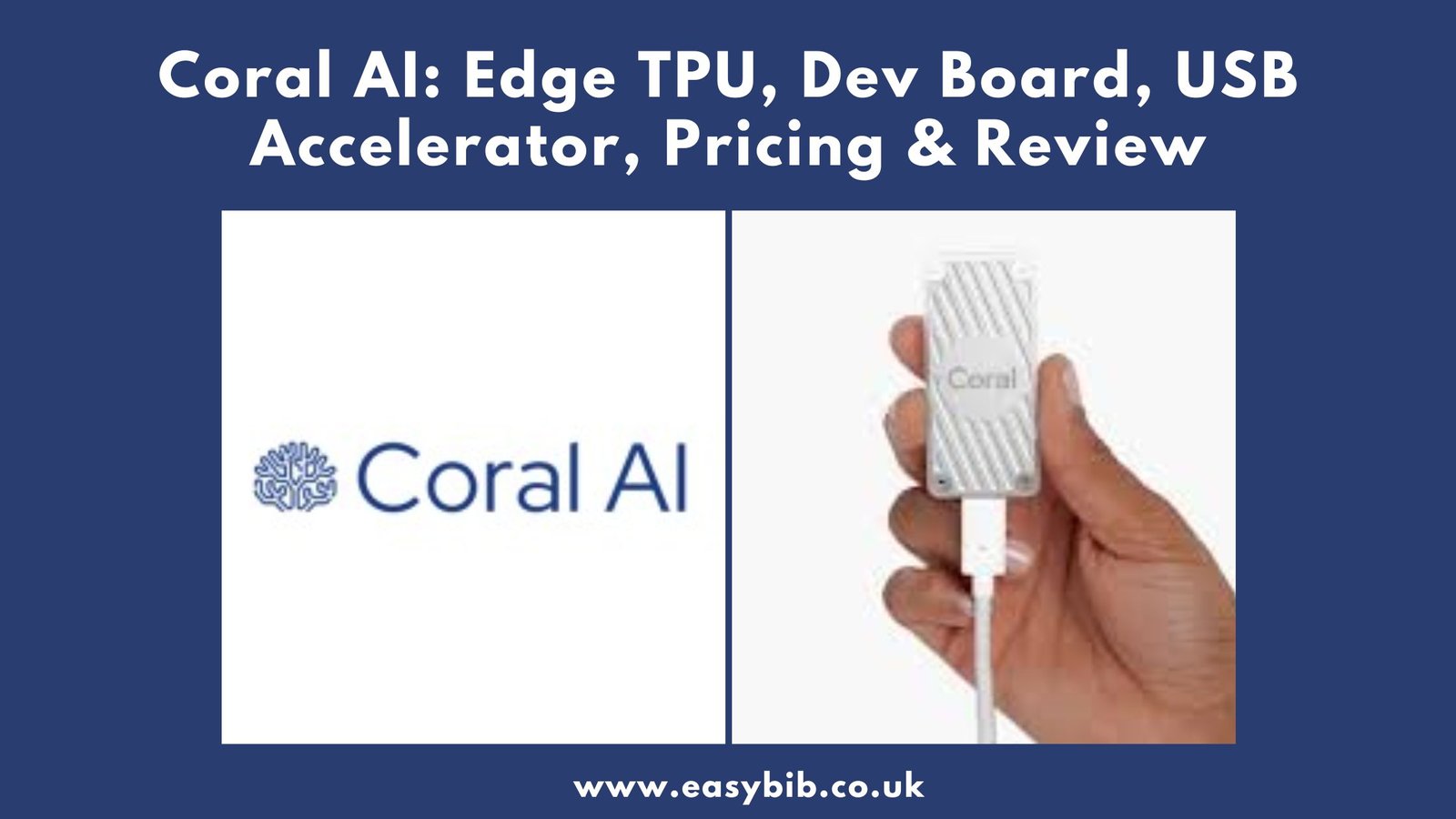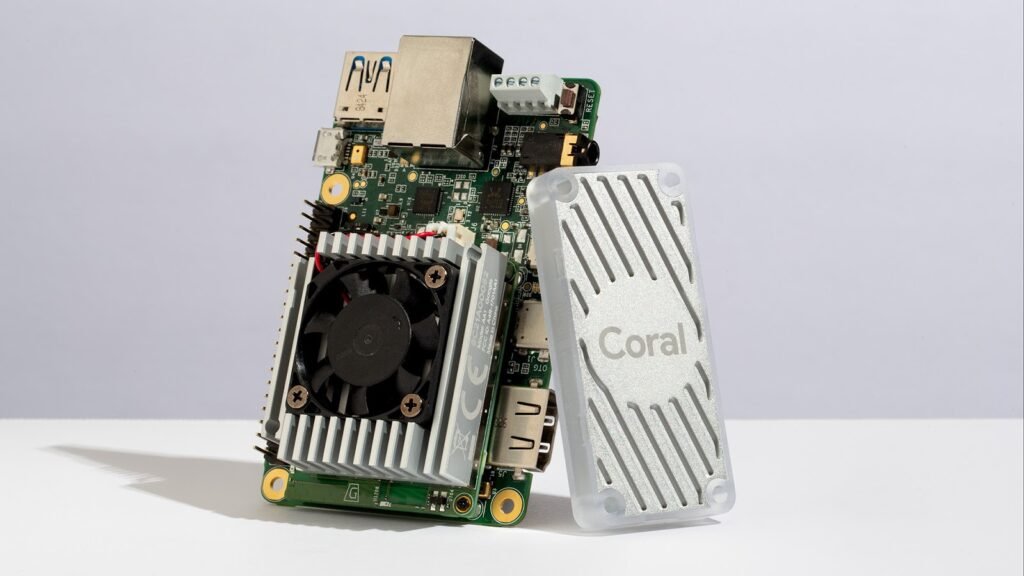Coral AI: Edge TPU, Dev Board, USB Accelerator, Pricing & Review

Coral AI is Google’s platform for running machine learning on devices at the edge. It allows AI applications to run locally without depending on the cloud. This improves speed, privacy, and energy efficiency. Coral combines hardware, software, and development tools to enable AI in IoT devices, robotics, smart cameras, and embedded systems. Developers can build real-time applications with minimal latency using Coral AI.
What Is Coral AI?
Coral AI is an ecosystem designed to bring AI to devices. Its main component is the Edge TPU, a processor optimized for TensorFlow Lite models. The Edge TPU accelerates inference for quantized neural networks, allowing applications to respond instantly. Coral supports applications like image classification, object detection, and pose estimation. By processing data locally, Coral reduces cloud dependency, ensures faster response times, and maintains privacy.
Key Components of Coral AI
Edge TPU Accelerator
The Edge TPU is the heart of the Coral AI ecosystem. It is a small coprocessor designed to run AI efficiently. It is optimized for low-power operations and handles quantized TensorFlow Lite models. The Edge TPU is available in USB devices, M.2 modules, PCIe modules, and integrated Dev Boards. This flexibility allows developers to use Coral for both experiments and production.
Coral Dev Board
The Coral Dev Board is a single-board computer with an integrated Edge TPU. It includes a processor, memory, storage, and network connectivity. The Dev Board runs Linux and supports TensorFlow Lite models directly. It is ideal for prototyping AI applications and testing real-world scenarios. Developers can quickly deploy models and experiment with AI features.
USB Accelerator
The Coral USB Accelerator brings Edge TPU functionality to existing systems. It works with Raspberry Pi, Linux PCs, and other embedded devices. This makes it a cost-effective solution for adding AI capabilities to existing projects. The USB Accelerator allows fast inference without buying a full Dev Board.
Accelerator Modules
Coral also provides M.2, Mini PCIe, and other modules for production integration. These modules let developers integrate the Edge TPU into custom devices. This makes it possible to scale prototypes into production-ready AI systems.
Software
It comes with software tools to deploy models on the Edge TPU. Developers can compile TensorFlow Lite models for the TPU. Tools allow model optimization and quantization for efficient execution. Example applications include object detection, classification, and pose estimation. Running models locally eliminates the need for constant internet access. This ensures privacy and real-time performance.
Pricing and Free Tools
The software and SDK are free to use. Developers can download compilers, guides, and example projects at no cost. Hardware must be purchased separately. Prices vary for Dev Boards, USB Accelerators, and modules. The Dev Board is more expensive than the USB Accelerator. Hardware costs are reasonable for prototyping and production purposes.
How Coral AI Works?

Using Coral AI involves several steps. First, developers train a model elsewhere, such as in the cloud or on a desktop. Then, the model is quantized to make it compatible with the Edge TPU. The TensorFlow Lite model is compiled using Coral tools.
Finally, it is deployed to the Coral device. The Edge TPU executes inference locally, providing fast and efficient results. Optimized models run in real-time and consume minimal power.
Use Cases for Coral AI
- It enables real-time object detection, facial recognition, and activity monitoring.
- Robots can use Coral for navigation, gesture recognition, and AI-based decision-making.
- Smart sensors and embedded systems can analyze data locally using Coral.
- Coral AI supports predictive maintenance, quality control, and factory automation.
- Coral enables offline voice recognition, gesture controls, and intelligent home automation.
Coral AI Review
It is praised for speed, energy efficiency, and flexibility. The Edge TPU delivers strong performance for quantized models. Developers like the Dev Board for rapid prototyping. Professionals benefit from modular options for production integration. Some challenges include working only with quantized models and learning the model compilation process. Despite this, Coral AI is widely regarded as a powerful edge AI platform.
Login and Platform Access
It does not require a traditional login. Developers access the platform via software tools and hardware devices. Documentation, SDKs, and tutorials are freely available online. Users work directly with the Edge TPU through their development environment. There are no subscription or login fees required.
Coral AI Documentation and PDF Resources
Google provides detailed PDF datasheets for Coral devices. These include Dev Boards, USB Accelerators, and modules. PDFs contain hardware specifications, deployment instructions, and software guides. They are free and help developers understand the capabilities of Coral AI hardware and software.
Tips for Using Coral AI
Check model compatibility with Edge TPU before deployment. Quantize models for efficient performance. Test AI applications with real-world samples. Verify power and connectivity requirements. Start with simple models before deploying complex ones. Maintain records of successful deployments for future reference.
Limitations
Edge TPU supports only quantized TensorFlow Lite models. Advanced models may need adjustments or retraining. Hardware availability can sometimes be limited. Users need to understand compilation and deployment workflows. Despite these limitations, Coral is suitable for most edge AI applications.
Final Thoughts
Coral AI is a complete platform for edge AI applications. It provides fast, efficient, and private machine learning on devices. Developers can use Dev Boards, USB Accelerators, and modules for prototyping or production. While hardware costs exist, software tools are free. It is ideal for embedded AI, robotics, IoT, and industrial automation. It combines performance, low latency, and flexibility in one ecosystem.
